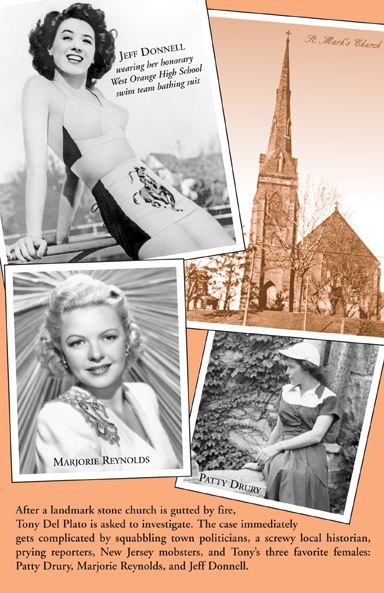Copyright © 2021 by the John Dandola, Ltd. All rights reserved. |
Dead in the Embers Will Finally Debut |
The Pandemic Delayed Production Not the Writing In all the years I have been writing these West Orange based mystery novels, in the back of my mind, I knew that at some point reality and fiction would meet in a head-on collision. Dead in the Embers will be that collision. I was on vacation when the real St. Mark's church in West Orange, New Jersey, was destroyed by fire. It hit me hard. The church building itself was no longer owned by the Episcopalians. A year or two before, due to a drastic decrease in parishioners, the building had been leased or sold to some independent Hispanic Christian organization. The cause of the fire seems to have been unlicensed handyman work in the basement for which no permits had been pulled. No charges were ever pressed. That's correct. The destruction of an historic nineteenth-century building resulted in no charges when that clearly should have brought about such things. In West Orange, history is only important if it is tied to political aspirations and, in this case, no politician could figure an angle in which to do that. In fact, during the late 1970's, an eighteenth-century house next to this very church was bulldozed into rubble overnight and without warning. The house was, in fact, being restored with private money but the then-mayor considered it an eyesore and he felt gentrifying the area best suited his political visions. The gentrification failed and the town was left with a shabby empty lot. St. Mark's church always fascinated me because of its dominance perching on a rise above the town center and because its brownstone construction caused it to glow orange at sunrise and sunset. I was told by regional-level Episcopalian officials that I was the only outside historian to ever express interest in the church and they gladly helped whenever I was writing one of my town histories. Hence, the pastor used in this novel is the actual pastor who was in charge during the 1940's. What I have done in Dead in the Embers is to transport the church fire back to 1944 where I could create a much better rationale for its destruction rather than the twenty-first century carelessness and apathy which caused it. This is where the collision will take place. When the novel was first announced as being undertaken, no one sought to make contact with me to properly use it to raise funds for restoration. I have done so with other organizations outside of New Jersey and I was entirely open to that in this case. Instead, politicians jockeyed and realized that I would not allow them to attach themselves to my work because I have never allowed them to attach themselves to my work. No one could grasp that contacting me should be only for the good of the building and not for the benefit of some office-holder or office-seeker. In their minds, such high-profile contact had to focus on them or they would have none of it. So, they had none of it. Now that the novel will finally debut by year's end, the usual West Orange backlash will come about. Usual? How so? First and foremost, West Orangers can't discern fact from fiction. It's why they accept made-up town history as truth. But out-and-out fiction, they can't identify. For their edification: a novel is fiction. That means incidents were created solely to tell a make-believe story for entertainment purposes. In West Orange, this will result with my being told constantly and continually that "those things never happened" then eluding to how dare I put forth lies. Yes, nine novels into this series and that nonsense always occurs. Yes, it's tiresome. Secondly, there is no appreciation whatsoever for my ability to recreate the town as it actually was. The inability to understand fiction overlaps with the inability to comprehend that fictional stories can be set in accurately-described settings. Nowadays, West Orange is too focused on over-development and trying to become an incompetently-run city rather than functioning as what it once was: a middle-class town. That happened because during the mid-1950's, West Orange politics became a three-ring circus and the town gradually transformed into a rudderless ship. Thirdly, in the novel, I touch upon how St. Mark's lost nineteenth-century stained glass windows can be recreated. How would I know how to do that? My background and skills in art. The church restoration, should it ever come about, will be like all things West Orange and that is the easiest method will be employed with no use of imagination. It will probably result in a stark modern interior with prefab windows made up of alternating panes of colored glass. But, even though it will fall upon deaf ears, my novel explains the proper and correct way to recreate the original lost windows without finding an artisan who can recreate the nineteenth-century styles and methods used in the originals. Still expensive? Yes. Appropriate? Absolutely. Will it be done? No. And so, in this collision, the novel won't receive any visibility in the town about which it is set. But as always happens, it will be accepted and even praised by outsiders both nationally and internationally for its depictions of that town. There's a sadness about that which I won't even delve into. Believe it or not, I've come to accept it. |
The 1940's wire service photo of Jeff Donnell is not PhotoShopped. She really did
have a bathing suit with the West Orange High School Cowboys emblem on it. |
